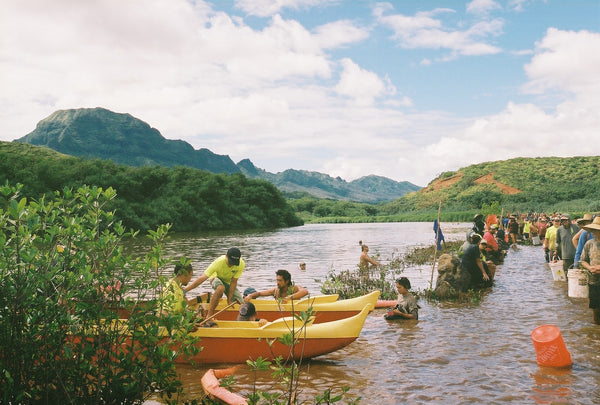E Kū Ana Ka Paia: Community Workday Restoring Alakoko Fishpond
November 28, 2023 – Haylin Chock

E iho ana o luna
E pi`i ana o lalo
E hui ana na moku
E ku ana ka paia
Adapted from Hawaiian Antiquities by David Malo
Hulēʻia Stream is the major waterway of the Nawiliwili Bay Watershed. The Nāwiliwili and Haʻiku ahupuaʻa were once a commerce hub of Kaua’i. The bay held the nearest safe anchorage for sailing ships from Honolulu, although it was rough until the breakwall was built in 1922. Nāwiliwili is now the main port for goods and cruise ships. In many ways, it still serves as a societal hub for gathering and importing goods. From the early 1920ʻs until about 1999, Alakoko fishpond located in the Haʻiku ahupuaʻa was left in disrepair, choked out by red mangrove.
Nāwiliwili was known to initially have six fishponds, of which Alakoko was the largest. Other known fishponds in the area were named Kalalalehua, Lokoponu, Papalinahoa, and two whose names have been lost to time. The winds of the region are also famous. They include the twisting wind Kiu Ke’e and the Hu’e One winds of Nāwiliwili; and at Kalapakī, the Wāmua and He Waikai Ko Kalapakī, which refers to the brackishness of the seawater due to all the freshwater springs and streams. The breezes blowing across the uplands of Līhu’e are the Pāhole winds. Niumalu, Nāwiliwili, and Haʻiku were a sanctuary for people fleeing wars on other islands. One story says that in 1785, when Kahekili invaded O’ahu, Princess Ruth Keʻeliōkalani came to Hulē’ia carrying a bit of soil from her birth island, which she spread out in her new home here on Kaua’i.
Mālama Hulē‘ia is a non-profit that began with the partnership of the Nawiliwili Bay Watershed Council and Kaiola Canoe Club. The Nawiliwili Bay Watershed Council (NBWC) was formed in 1999 as a group of concerned citizens who united to stop the degradation of watersheds feeding into the Nawiliwili Bay (including the Hulē‘ia, Pū‘ali, Papalina Hoa, and Nāwiliwili Streams).
The group’s four priority goals were:
- Restoration of Alakoko Fishpond.
- Collaborate with water rights advocacy groups to correct stream diversions.
- Controlling nonpoint sources of water pollution.
- Restoration of loʻi kalo on kuleana lands.

The Kaiola Canoe Club, a local paddling club and non-profit, is the mother organization of Mālama Hulē‘ia. Kaiola Canoe Club members felt the urgency to do something about the red mangrove invasion of the Hulē‘ia River and responded by forming Mālama Hulē‘ia. Before the early 1900s, there were no mangroves in the Hawaiian Archipelago. In 1902, Rhizophora mangle was introduced on the island of Molokai, primarily to stabilize coastal mudflats. This species is now well established all over Hawaiʻi. Mangroves had overtaken many ancient fishponds along with Alakoko. Pae Pae o Heʻeia in Heʻeia Oʻahu was once overgrown, but with diligent work of the community and non-profit efforts, it’s now a restored and functioning fishpond. Mangrove reduces habitat quality for endangered water birds such as the Hawaiian stilt (Himantopus mexicanus Knudsen), fosters an environment to harbor invasive weeds, overgrow native Hawaiian archaeological sites, and causes sediment build-up drainage problems.
The efforts of Mālama Hulēʻia since 2009 until now have primarily focused on recovering the area from mangroves. Thanks to the tireless efforts and thousands of volunteer hands, the last of the significant sections of mangrove covering the original Kuapā was eliminated around 2022. It had taken around a decade to get to a point where it has become a worksite free of invasive trees and mangrove sediment build up. The organization now has a full-time staff of seven and often hosts volunteer groups.

On October 21st, 2023, the organization held the ʻE Kū ana ka Paia' event. This event was a community event to mark the turning point in restoration. An estimated 2,000 people flew in and signed up to participate. Peleke Flores and staff held pōhaku dry stacking classes leading to the big day. The event had all ages participating in some way, whether people were carrying rocks, building wall sections, or supporting entertainment, food, or crafts. The original kuapā had not been made for around 800 years or when it was first built. At noon, they held a ceremony to center all the volunteers and bring everyone together for this historic occasion. The nearly 2000 participants fell silent as Pelekeʻs voice carried over the speakers, the glassy water. We began to oli. E iho ana, E pi`i ana o lalo, E hui ana na moku, E ku ana ka paia! The ceremony continued with pahu drums and oli reverberating off the neighboring valley faces. A handful of times, a person can stand in awe, like in this moment, to be connected directly to work done long before our world could be imagined. Everyone was ecstatic to return the next workday and further the work of Mālama Hulēʻia and return this ʻāina to its former glory so that it may once again feed our community. Mahalo Peleke and the staff at Mālama Hulēʻia, thank you for all the work you continue to do for future generations.
Photo Credit: Mikey Salomone @mikeydready
